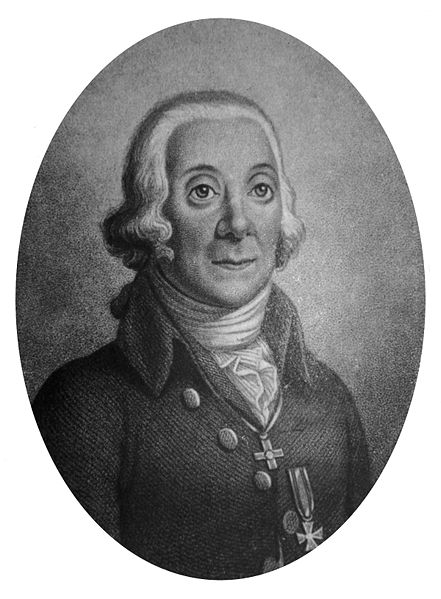<Back to Index>
- Zoologist and Botanist Peter Simon Pallas, 1741
- Writer John Home, 1722
- Field Marshal of the Wehrmacht Wilhelm Bodewin Gustav Keitel, 1882
PAGE SPONSOR

Peter Simon Pallas (22 September 1741 – 8 September 1811) was a German zoologist and botanist who worked in Russia.
Pallas was born in Berlin, the son of Professor of Surgery Simon Pallas. He studied with private tutors and took an interest in natural history, later attending the University of Halle and the University of Göttingen. In 1760, he moved to the University of Leiden and passed his doctor's degree at the age of nineteen.
Pallas traveled throughout the Netherlands and to London, improving his medical and surgical knowledge. He then settled at The Hague, and his new system of animal classification was praised by Georges Cuvier. Pallas wrote Miscellanea Zoologica (1766), which included descriptions of several vertebrates new to science which he had discovered in the Dutch museum collections. A planned voyage to southern Africa and the East Indies fell through when his father recalled him to Berlin. There, he began work on his Spicilegia Zoologica (1767 - 80).
In 1767, Pallas was invited by Catherine II of Russia to become a professor at the St Petersburg Academy of Sciences and, between 1768 and 1774, he led an expedition to central Russian provinces, Povolzhye, Urals, West Siberia, Altay and Transbaikal collecting natural history specimens on their behalf. He explored the Caspian Sea, the Ural, Altai mountains and the upper Amur, reaching as far eastward as Lake Baikal. The regular reports which Pallas sent to St Petersburg were collected and published as Reise durch verschiedene Provinzen des Russischen Reichs [Journey through various provinces of the Russian Empire] (3 vols., 1771 - 1776). They covered a wide range of topics, including geology and mineralogy, reports on the native peoples and their religions, and descriptions of new plants and animals. In 1776, Pallas was elected a foreign member of the Royal Swedish Academy of Sciences.
Pallas settled in St Petersburg, becoming a favourite of Catherine II and teaching natural history to the Grand Dukes Alexander and Constantine. He was provided with the plants collected by other naturalists to compile the Flora Rossica (1784 - 1815), and started work on his Zoographica Rosso - Asiatica (1811 - 31). He also published an account of Johann Anton Güldenstädt's travels in the Caucasus. The Empress bought Pallas's large natural history collection for 2,000 roubles, 500 more than his asking price, and allowed him to keep them for life.
Between 1793 and 1794, Pallas led a second expedition to southern Russia, visiting the Crimea and the Black Sea. He was accompanied by his daughter (by his first wife who had died in 1782) and his new wife, an artist, servants and a military escort. In February 1793 they travelled to Saratov and then downriver to Volgograd. They spent the spring exploring the country to the east, and in August travelled along the banks of the Caspian Sea and into the Caucasus mountains. In September they travelled to the Crimea, wintering in Simferol. Pallas spent the spring of 1794 exploring to the southeast, and in July travelled up the valley of the Dnieper, arriving back in St Petersburg in September. Pallas gave his account of the journey in his P.S. Pallas Bemerkungen auf einer Reise in die Südlichen Statthalterschaften des Russischen Reichs (1799 - 1801). Catherine II gave him a large estate at Simferol, where Pallas lived until the death of his second wife in 1810. He was then granted permission to leave Russia by Emperor Alexander, and returned to Berlin, where he died in the following year. His grave is preserved in the Protestant Friedhof I der Jerusalems- und Neuen Kirchengemeinde (Cemetery No. I of the congregations of Jerusalem's Church and New Church) in Berlin - Kreuzberg, south of Hallesches Tor.
In 1772, Pallas was shown a 680 kilogram lump of metal which had been found near the city of Krasnoyarsk.
Pallas arranged for it to be transported back to St Petersburg.
Subsequent analysis of the metal showed that it was a new type of
stony - iron meteorite. This new type of meteorite was called Pallasite after him, whereas the meteorite itself is named Krasnojarsk or sometimes also called Pallas Iron (the name given to it by Ernst Chladni in 1794). A number of animals are named after Pallas, including Pallas's Cat, Pallas's Long-tongued Bat, Pallas's Tube-nosed Fruit Bat, Pallas's Squirrel, Pallas's Warbler, Pallas's Cormorant, Pallas's Fish-eagle, Pallas's Gull, Pallas's Sandgrouse, Pallas's Rosefinch, Pallas's Pika, Pallas's Reed Bunting and Pallas's Grasshopper Warbler. Streets in Berlin and Castrop - Rauxel are named Pallasstraße. A city in Volgograd Oblast is named after him - Pallasovka and his monument stands there. An asteroid is named after him: 21087 Petsimpallas.